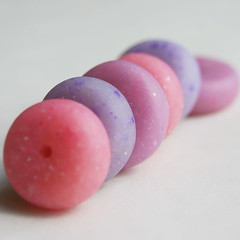One of the techniques I've played around with over the past month or two is using crayon shavings as inclusions in translucent polymer clay. It's lots of fun and extremely easy-- a great project to share with kids (though you'll want to chop the crayons for them, if they're very young).
I first read about this technique on Lindly Haunani's website. Here's a link: Altering Polymer Clay with Inclusions. She discusses a variety of other inclusions, too, so it's a good read if you're new to the idea.
Here are a few things I noticed and/or did when I made my crayon-inclusion beads:
- As Lindly points out, some of the colors can be unpredictable. They may not come out of the oven exactly the same as they went in. Some intensify; others seem to fade. This isn't a problem if you're just having fun, but if you require specific results, you'll want to bake some test chips.
- I used very cheap "off-brand" crayons bought on sale. They're pretty worthless as crayons-- very poor performance in coloring books, etc.-- but they still make good inclusions. So if you have a box of poor quality crayons, you might consider trying this technique with them.
- I took shavings from the crayons, then chopped those into small bits before mixing into the clay. I then used a craft knife to further chop any larger pieces of crayon in the clay mix. It's not always necessary to chop the crayons that much, but it is the look I prefer. However, all that chopping can be time-consuming and tedious. I don't know how well a food processor would work with crayons (seems a bit messy), but it's an idea, if you need a lot of crayon chopped finely.
- I added some embossing powder into my mix for a different look. The beads in the photo above have seafoam white embossing powder as an inclusion in addition to the crayon shavings.
- Maybe it was just a lucky chance-- a good batch of clay, cool/dry weather, a fortuitous alignment of the stars ;o)-- but it seemed to me that these mixes of clay were slower to take fingerprints than regular ("inclusionless") clay. Adding certain inclusions (especially powders) does seem to "dry" the clay out a little, which makes it easier to avoid fingerprints-- and the slightly uneven surface resulting from these types of inclusions may make it less obvious if there are prints.

5 comments:
Great post! I liked the idea of adding embossing powder as well as the crayons in the clay. I just did a post myself on crayons in clay. Great minds do think alike!
Thanks!
(g) Yes, I happened to find your post a day or so after writing mine and thought it was a funny coincidence. I must be just the right time of year for all those bright crayola colors. ;o)
Those are pretty! I love the flecked look and the matte finish.
I'm all about avoiding fingerprints, so I should try this!
Funny, I just saw Cindy Lietz' post about crayons a couple of days ago and then here. Y'all are making me want a box of Crayolas and a trip down memory lane!
Hi, I want to try the technique of inclusion. I have already made with the oil colors and the effect was beautiful.
Yes, definitely get a box of crayons! The smell alone is worth the price. ;o)
Twizzy, it's a really fun technique. :o)
Post a Comment